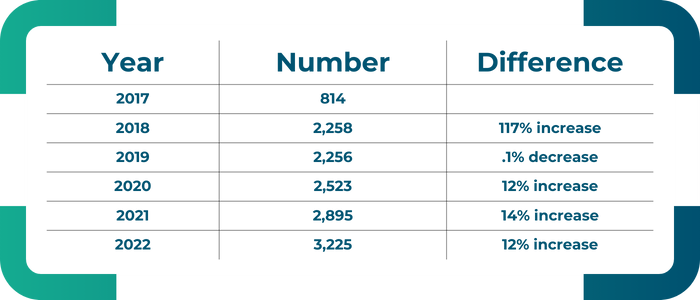As Baby Boomers approach retirement age, ensuring that your website is ADA and senior-friendly isn’t just a choice; it’s a necessity that embraces inclusivity and opens doors to a broader audience. With less than 12 percent of marketing and web budgets being allocated towards reaching this audience and even less than that being spent towards building accessible websites, there is a huge opportunity to stand out from your competition and provide a great user experience for this untapped demographic.
If you still aren’t convinced or do not know where to start, keep reading; we’ve done the research for you.
Providing Engaging Digital Experiences for Everyone
In today’s dynamic digital landscape, crafting a website that is both ADA and senior-friendly is no longer an option but a compelling necessity. The statistics speak volumes: as the global demographic shifts towards an aging society, with over 20% of the world’s population projected to be 65 years or older by 2030 (US Census Bureau), the demand for senior-friendly online experiences is burgeoning. Moreover, approximately one in four Americans possess some form of disability, underscoring the imperative of ensuring accessibility for this significant portion of the population.
Considering these significant demographics in our population, the importance of crafting websites accessible to seniors and individuals with disabilities is evident. Age-related cognitive decline, reduced vision, and motor skill limitations can pose challenges for the elderly while navigating the internet. By implementing senior-friendly design features like larger fonts, clear navigation, and intuitive layouts, we can enrich the older users’ experience, serving a substantial user base and cultivating positive relationships and customer loyalty.
Bottom Line
Your website or portal should provide an engaging user experience that is accessible to your ENTIRE target audience, not just a portion of it. Accessible websites open doors to new opportunities and potential customers while reinforcing a company’s commitment to inclusivity and social responsibility.
The Legality of it All
The Americans with Disabilities Act (ADA) was signed into law in 1990 and in 2018 the Department of Justice confirmed that digital spaces, such as websites and portals, were considered a place of public accommodation and were therefore covered under the law. The Web Accessibility Initiative (WAI) of the World Wide Web Consortium (W3C) has since published and made continuous updates to the Web Content Accessibility Guidelines (WCAG) to ensure ADA compliance in digital spaces.
The count of lawsuits related to web accessibility brought before federal court under Title III of the Americans with Disabilities Act (ADA) have, on average, increased year over year. While accessibility has become a priority and requirement of many companies and organizations, still more than 90% of all websites are deemed as inaccessible. As numerous reports highlight a rapid increase in lawsuits directed at website owners for ADA compliance violations in the first half of 2023, the financial risk to guarantee compliance is also increasing.

Bottom Line
The number of filed accessibility federal lawsuits has increased exponentially each year, with settlements ranging from 5K to 20K. These numbers do not include cases filed in state courts, demand letters, and DOJ enforcement actions resolved before a suit is filed.
The Economic Rationale
Embracing these design principles not only reflects a commitment to inclusivity and ethical practice but also makes economic sense. It’s projected that Baby Boomers will inherit $15 trillion over the next 20 years and have become the fastest-growing group of online shoppers since 2020. Even if your website does not have an ecommerce component to it, the aging population is spending more and more time online, conducting research and looking for companies that meet their needs.
Accessible websites command higher customer satisfaction rates and potentially open doors to a market share that businesses might otherwise miss. Companies that prioritize inclusivity often experience positive feedback and increased customer loyalty. A survey conducted by the Click-Away Pound research initiative revealed that 71% of disabled customers with access needs had left a website due to poor accessibility. Neglecting web accessibility could cost businesses valuable revenue. Infusing your website with ADA and senior-friendly features is a seamless mix of social responsibility and strategic insight, resulting in an inclusive digital space for all, regardless of age or ability.
Bottom Line
Websites that adhere to WCAG Level 2 are projected to outperform their counterparts by 50% in terms of customer satisfaction. (Gartner). By investing in website accessibility, businesses can tap into a large and often underserved market segment, driving growth and profitability.
The SEO Ripple Effect
Search engines, like Google, consider website accessibility a factor when ranking search results. Not only that but ADA compliance guidelines often align with factors analyzed by Google’s algorithm. Building an accessible site includes the use of well-structured content, clear headings, alt text for images, descriptive links, and a mobile-friendly design.
By adopting an inclusive approach to web design, businesses can enhance their online visibility and attract a broader audience. This results in higher traffic, reduced bounce rates, longer user sessions, higher on-page engagement, and an increase in social shares and online visibility. All of these user signals are factors the mighty Google algorithm considers when determining page rankings.
Bottom Line
By striving for accessibility and inclusivity, you create a more user-friendly and search engine-friendly website, which ultimately improves your online presence, reach, and rankings.
The (Ultimate) Bottom Line
The importance of creating senior and ADA-friendly websites cannot be overstated. As the world becomes increasingly connected, it is essential to ensure that everyone, regardless of age or ability, can access the vast resources and opportunities available online. By embracing inclusive web design, businesses demonstrate their commitment to social responsibility, customer satisfaction, and long-term growth resulting in a digital space that welcomes and serves all, regardless of age or ability.
Now that you have learned the importance of ADA-Friendly Websites, let’s put that knowledge to work and see how optimized your website actually is with this Page Speed Optimization Guide.



